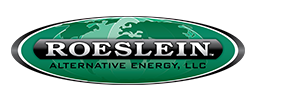Published by Farm Forum
Roeslein Alternative Energy (RAE) announced that the first Renewable Natural Gas (RNG) produced from methane captured using covered manure lagoons at a Smithfield Hog Production farm near Albany, Missouri is now being injected into the national pipeline for distribution and use across the country. The completion of RNG production facilities at Ruckman Farm is a significant milestone for the $120 million project, which is the largest manure-to-energy project of its kind.
The project represents a potential paradigm shift for agriculture, the environment and wildlife.
“Technologically we have a very sound system. This is a world-class operation,” said Rudi Roeslein, President and Founder of Roeslein Alternative Energy who has personally invested $40 Million in the project. “What we hope to do is demonstrate that we can take the lead in alternative energy and environmental impact, and do it in a way that is profitable for farmers.”
Significant renewable energy, environment and habitat benefits
All nine Smithfield Hog Production facilities in Northwest Missouri will soon feature this innovative technology. It is one of the largest concentrations of market hogs in the Midwest with nearly two million hogs annually.
When completed the hog manure from the project will produce approximately 2.2 billion cubic feet of pipeline quality RNG, or the equivalent of 17 million gallons of diesel fuel annually (17 million DGE) which is the rough energy equivalent of filling 56,000 big rig trucks with a full tank of diesel fuel per year. The project’s focus is to reduce greenhouse gas emissions, produce RNG, eliminate rainfall effects of treatment systems and generate additional jobs for the surrounding community.
“This project touches on every aspect of our company’s commitment to sustainability. That means animal care, employees, the environment, food safety, healthy communities and value creation,” said Michael Rainwater, General Manager Smithfield Hog Production Missouri.
“Smithfield is constantly looking for ways to innovate, and plans to be involved in these types of projects over the long term,” said Stewart Leeth, vice president and chief sustainability officer for Smithfield Foods.
Horizon One: Benefits for the livestock industry
Horizon One of the project is nearly 50 percent complete, with impermeable synthetic covers installed on 41 of the 88 existing manure lagoons at Smithfield’s nine Hog Production farms. The covers reduce greenhouse gases by preventing methane from escaping to the atmosphere, keep rainfall from entering the lagoons and reduce odor.
The covers also enable the recovery of biogas formed from the natural anaerobic conversion of manure in the lagoons. As an interim step the biogas has been flared. The project at Ruckman Farm features an integrated facility that refines captured biogas into pipeline quality natural gas. The resulting RNG is then injected into the natural gas transmission system through an inter-connection to a pipeline operated by ANR, which crosses Ruckman Farm.
“The important thing for us is that we are able to achieve these kinds of goals with techniques, systems and technologies that are available today. And with a project that makes economic sense today,” said Chris Roach, Director, Roeslein Alternative Energy. “The environmental benefits are significant.”
Duke Energy in North Carolina has agreed to purchase a portion of the RNG to help meet clean energy requirements for power generation.
• Approximately 850,000 tons of CO2 equivalent methane will be prevented from reaching the atmosphere when the Horizon One is complete.
• The project is providing $120 million in new work for Missouri supply chain, manufacturing, and construction companies and their employees
Horizon Two: Biomass from native prairie grasses to create more RNG
Roeslein Alternative Energy intends to supplement the hog manure feedstock with biomass harvested from restored prairie grasslands to produce additional RNG. The intent of Horizon Two is to provide an economic incentive to convert highly erodible or marginal land to environmentally beneficial prairie.
“We are developing a mixture of grasses and native species that provide ecological services, wildlife habitat and biomass that will be co-digested with manure,” Roeslein said. We hope to demonstrate the concept on a small scale at Ruckman, move it to other farms and then hopefully across the Midwest.”
Collaboration among many entities to drive progress
The entire project is the result of collaboration with a number of entities including universities, government agencies and the conservation community including:
• The University of Missouri, Iowa State University, University of Minnesota
• U.S. Fish and Wildlife Service, Missouri Department of Conservation
• Midwest Biomass Alliance, Missouri Prairie Foundation, National Wild Turkey Federation, The Nature Conservancy, Eastern Tallgrass Prairie & Big Rivers Landscape Conservation Cooperative (ETPBR LLC)
Here is an example of collaboration among various entities. The ETPBR LLC has agreed to fund a $100,000 native prairie restoration monitoring program to be implemented by Iowa State University on 200 acres of land Smithfield Hog Production Missouri has made available near the RNG facility at Ruckman Farm. The monitoring program seeks to establish best management practices for the greatest mutual benefits for wildlife, the environment, energy production and ultimately a more productive use of assets.
RAE believes the project can be emulated in farms across the United States and that it has applications for developing countries around the world seeking ways to sustainably manage natural resources and energy production. RAE ultimately seeks to restore 30 Million acres of land to native prairies in 30 years to dramatically increase wildlife habitat while creating significant ecosystem services such as cleaner water, erosion prevention, and soil rebuilding.

